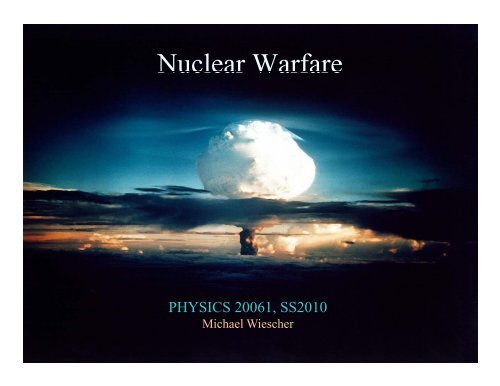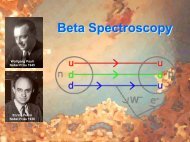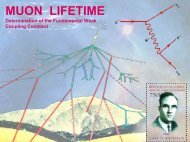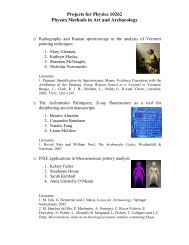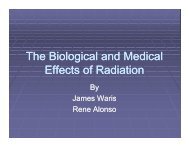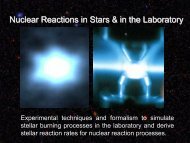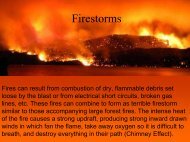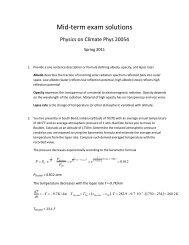Nuclear Warfare - ISNAP
Nuclear Warfare - ISNAP
Nuclear Warfare - ISNAP
Create successful ePaper yourself
Turn your PDF publications into a flip-book with our unique Google optimized e-Paper software.
<strong>Nuclear</strong> <strong>Warfare</strong><br />
PHYSICS 20061, SS2010 ,<br />
Michael Wiescher
Lecturers<br />
Qian Li<br />
Michael Wiescher, Physics<br />
Luc Reydams, Law
28,800: The total number of intact nuclear warheads retained by the United States and Russia.<br />
30,000: Number of intact nuclear warheads throughout the world. 17,500 of these are operational.<br />
128,000+: Estimated number of nuclear warheads built worldwide since 1945.<br />
All but 2 percent of these nuclear warheads have been built by the<br />
United States (55 % or 70,000+) and Russia (43 % or 55,000+).<br />
10,729: Total number of intact U.S. nuclear warheads (274 warheads are awaiting dismantlement)<br />
10,455: Total warheads in the U.S. stockpile<br />
~7,000: Number of operational strategic U.S. nuclear weapons<br />
~1,600: Number of U.S. tactical nuclear weapons (~800 of these are operational)<br />
8,400: Total number of operational nuclear warheads in Russian arsenal<br />
5,000: Approximate number of Russian strategic nuclear weapons<br />
3,400: Approximate number of operational Russian tactical nuclear weapons<br />
(total tactical arsenal said to comprise as many as 10,000+ weapons)<br />
3,500: Approximate number of strategic U.S. nuclear weapons, year 2003 under START II.<br />
3,000: Approximate number of strategic Russian nuclear weapons, year 2003 under START II.<br />
~2,000: Maximum number of deployed strategic nuclear weapons that will remain in the U.S.<br />
and Russian arsenals by 2012<br />
( The Treaty of Moscow (also known as SORT) signed by U.S. President George W. Bush<br />
and Russian President Vladimir Putin in May 2002.<br />
10,000: The number of warheads the United States will retain in 2012<br />
(essentially the same number as today)<br />
Fact Sheet<br />
$3.5 trillion: Amount the United States spent between 1940 and 1995 to prepare to fight a nuclear war.<br />
$27 billion: Amount the United States spends annually to prepare to fight a nuclear war.<br />
$2.2 2 billion:<br />
Cost for one B-2 2bomber b (21 were authorized dby Congress).<br />
$2.5 billion: The lifecycle cost of each B-2 (RDT&E, procurement, operations, maintenance, support).<br />
The figures cited above were gathered with the aid of resources from the National Resources Defense Council<br />
(NRDC) www.nrdc.org and the Secretary of Defense Office http://www.acq.osd.mil/ncbdp/nm/index.htm
The History of<br />
warfare in the<br />
20 th century
The Physics<br />
of the bomb<br />
b
Technical Design of Bomb<br />
Fat Man.exe<br />
Little Boy.exe
Popularization of the Bomb<br />
the Fear Factor
Duck and Cover
The Bomb Show<br />
the weapon test series 1945-19631963
Medical Consequences<br />
"Lethal effects of radiation can be summarized briefly: a very high dose (5000 rads +)<br />
causes death in hours; a smaller but lethal dose (400 rads +): death in weeks. In the<br />
latter case, sickness starts with diarrhea and vomiting, followed by some temporary<br />
improvement, and then the same symptoms recur with the addition of hemorrhage,<br />
anemia, infections, and a slow death."<br />
The U.S. "Federal Emergency Management Agency" predicts approximately<br />
86,000,000 people dead and 34,000,000 severely injured in the United States.<br />
There are about 2,000,000 hospital beds in Canada and U.S.A. combined.
Business Opportunities & Ethics
Ecological Consequences<br />
Fall-Out
International <strong>Nuclear</strong> Weapon Treaties<br />
1963 Limited Test Ban Treaty<br />
1967 Outer Space Treaty<br />
1968 <strong>Nuclear</strong> Non-Proliferation Treaty<br />
1972 Strategic Arms Limitation Treaty I ABM treaty<br />
1972 Strategic Arms Limitation Treaty I Interim Agreement<br />
1979 Strategic Arms Limitation Treaty II<br />
1987 Intermediate-Range <strong>Nuclear</strong> Forces Treaty (INF)<br />
1991 Strategic Arms Reduction Treaty<br />
1993 Strategic Arms Reduction Treaty II<br />
1996 Comprehensive Test Ban Treaty (CTBT)
Personal Conscience<br />
“Thou shalt not kill”
“Now I am become death, the destroyer of worlds."
The Bomb Test Series<br />
Scientific Hubris?
Syllabus<br />
The course on <strong>Nuclear</strong> <strong>Warfare</strong> PHYS 20061 is offered by the Physics<br />
Department, co-listed by the Reilly Center of Technology and Values and the<br />
Kroc institute for International Peace Studies as an introductory course for<br />
non-science majors to provide an overview about the broad range of topics<br />
and aspects of nuclear weapons and warfare in the 20th century.<br />
Class Content<br />
The course will start with the history and emergence of weapons of mass<br />
destruction technologies as a consequence of World War I and World War II,<br />
culminating in the development and use of the nuclear bomb. This will be<br />
followed by a discussion of the underlying physics principles to provide the<br />
necessary background for a basic understanding of nuclear weapons<br />
techniques and nuclear weapons effects as well as the decay radiation<br />
driven consequences. These consequences will be discussed in terms of<br />
short-range, atmospheric, biological, and medical effects together with the<br />
implications for social groups and societies. This will be complemented by an<br />
extensive discussion of the legal, political, and ethical implications of<br />
possession and use of nuclear weapons and nuclear warfare.
Class Content<br />
& Participation<br />
<strong>Nuclear</strong> <strong>Warfare</strong> Tuesday, Thursday 2:00-3:15 pm<br />
Date Subject Topic Lecturer<br />
12-Jan-10 Introduction and Overview Wiescher<br />
14-Jan-10 Modern <strong>Warfare</strong> in the 20th Century Wiescher<br />
19-Jan-10 Radioactivity, the New Toy, 1900-1933 Wiescher<br />
21-Jan-10 Decay and Energy, <strong>Nuclear</strong> Physics for Pedestrians Wiescher<br />
26-Jan-10 The Total War Wiescher<br />
28-Jan-10 The Dawn of the <strong>Nuclear</strong> Age 1939-1944 Wiescher<br />
‣ 10 Group projects (~4 students)<br />
associated with class content :<br />
1 lecture for each group<br />
‣ Participation & Discussion<br />
‣ Concentration ti points for class:<br />
3 questions/lecture<br />
‣ x
Class Presentations<br />
Date topic student 1 student 2 student 3 student 4<br />
16-Feb-10<br />
4-Mar-10<br />
18-Mar-10<br />
23-Mar-10<br />
30-Mar-10<br />
1-April-10<br />
6-Apr-10<br />
13-Apr10<br />
22-Apr-10<br />
Ethical Conflict and moral<br />
Objection<br />
Strategic Decisions on <strong>Nuclear</strong><br />
Armament<br />
Failed Nonproliferation, from India<br />
to Iran<br />
<strong>Nuclear</strong> Age Society, the <strong>Nuclear</strong><br />
Hype<br />
Destructive Power of <strong>Nuclear</strong><br />
Weapons<br />
Biological and Medical Effects of<br />
Radiation<br />
New Strategic Weapon<br />
developments<br />
Environmental Effects, <strong>Nuclear</strong><br />
Winter<br />
Economic Aspects, the Military<br />
Industrial Complex<br />
Michael Ceoteau Catherine Flatley Eric Nesi Casey Robinson<br />
Ryan Renacci<br />
Samuel Clark Brian Loughery Joseph Meares<br />
Kevin Partington<br />
Greg Cunningham Joslyn Jose Jean Namkung Tamuto Takakura<br />
Corey Brady Jose Carranza Christopher Collins Ryan Coughlin<br />
John Burke Nicholas DiStefano Luke Kippenbrock James Young<br />
Rene Alonso Michael Purcell Molly Smith James Waris<br />
Jesse Casadan Daniel Iwanski James Tucci Ryan Webster<br />
Chase Cavanaugh Brandon Chynowth David Goldberg Joseph Livingston<br />
Andrew Balhoff Brian Jacobs Mark Kramer Patricia Navas<br />
27-Apr-10 <strong>Nuclear</strong> Terror, <strong>Nuclear</strong> Fear Hector Benavides Emily Degan Josephine Franske Christina Konkey


